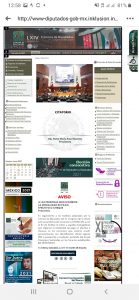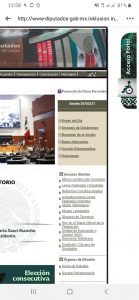Introduction
This post is a collection of random writings on the innovation of different parliament, particularly on bilingualism and having disability-friendly websites. It is a hotch-potch of posts written on different dates mostly on Facebook and Linkedin.
Canada
Going through the website for Canada’s House of Commons (there’s Senate too), you get to experience their bilingual prowess.
Their website has unilingual and bilingual buttons for their legislation. In Canada, their legislation is in both English and French.
Take an example of this one bill, Bill C-2 . See that unilingual/bilingual button up there. See that button next to it for the XML version. See the PDF version. Scroll down the Table of Contents on the right. See how easy it is.
In Kenya, we should be having legislation in both English and Kiswahili. Canada’s Parliament leads the way. We should emulate them.


Congreso de la Unión ( Mexican Parliament)
Taking a tour of the website for Congreso de la Unión ( Mexican Parliament), any person with visual impairment will be happy.
They have Acceso Portal for PWDs with such buttons as control de audio, Tamano de letra, Contraste, Opciones adicionales, Soluciones de navegacion, Ayuda and Cerrar barra de opciones accesibles.
It is sad that most parliaments have not configured their websites to PWDs. A person with visual impairment for instance is completely locked out from accessing materials that are important to him or her as a citizen.
How far as a country have we implemented Article 7(3) (b) of the Constitution?
We always assume that we won’t be disabled at any point in our lives but a small incident can take us there. Let us not wait until we are PWDs for us to reimagine an inclusive society.
You can dig into the Congreso de la Unión’s website by clicking on this link.
#PWDs #InclusiveParliaments #Parliament #Mexico #CongresodelaUnión #disability


Rwandan Parliament
The Rwandan Parliament is bicameral. It consists of the Senate and the Chamber of Deputies. The bicameral system replaced the National Transitional Assembly established in the aftermath of the 1994 Genocide against the Tutsi.
When you visit its website and you head to their Bills, you are awestruck by their trilingual legislation. Their laws are in English, Kinyarwanda and French. As you will realize, Kinyarwanda is their national language and it is also an official language. It is like our Kiswahili in Kenya. Apart from Kinyarwanda, their official languages are French, English and Swahili (yes, you got that right). They also have the Rwandan Sign Language in the same way we have the Kenyan Sign Language in our Katiba.
The Bills uploaded are about 18 and they are in those three languages (Kinyarwanda, English and French; in that order and arranged in three columns). This is commendable and I must express my gratitude to the Rwandan Parliament. Most importantly, I have not yet stumbled upon any writing on their experience on translation of their laws to those languages. I will keep looking and hopefully when I visit Rwandan Parliament in future this is one of the issues I have keen interest to learn on.
Tanzania
The Parliament of the Republic of Tanzania and House of Representatives, Zanzibar, are our leading lights in the use of Kiswahili.
I constantly visit the websites of these Houses to study how they are using Kiswahili in all facets of conduct of parliamentary business. I am disappointed though that after trawling the Bills before the Parliament of the Republic of Tanzania there is none in Kiswahili. They are a few drafted in English but named in Kiswahili (there are 11 Subsidiary Legislation in Kiswahili). However, their Hansard is in Kiswahili and so are their deliberations. The Ministers Statements are in Kiswahili; the Order Papers are in Kiswahili. The Auditor-General’s Reports are in Kiswahili. Take the example of one of the 2015 reports titled ‘Ripoti ya Mdhibiti na Mkaguzi Mkuu wa Hesabu za Serikali Kuhusu Ukaguzi wa Taarifa za Fedha za Miradi ya Maendeleo kwa Mwaka wa Fedha Ulioishia Tarehe 30 Juni, 2015’. That report is 282-page long. The Resolutions are also in Kiswahili.
Most of the Subsidiary Legislation are in English but I was pleased to chance upon ‘Kanuni za Uendeshaji wa Shughuli za Sekretarieti ya Ajira Katika Utumishi wa Umma’ drafted in Kiswahili’; ‘Tafsiri ya Kanuni za Kanuni za Mafunzo ya Uanagenzi za Mwaka 2012’; ‘Tafsiri ya Kanuni Mwenendo wa Mahakama ya Watoto za Mwaka 2014’, and others making them a total of 11 Subsidiary Legislation in Kiswahili.
I also found Pius Msekwa’s small publication on committees titled ‘Nafasi ya Kamati za Bunge Katika Uendeshaji wa Shughuli za Bunge’ and a relatively longer (44-page publication) titled ‘Lijue Bunge la Tanzania’. Of course the Members always impress me for their use of Kiswahili in their proceedings. I have my misgivings by the way they mix English and Kiswahili in their speeches but that is a topic for another day.
Baraza la Wawakilishi la Zanzibar is very resourceful for committee reports and ministerial budgets written in Kiswahili. It goes without saying that their Hansard and Order Papers are in Kiswahili. I was pleasantly surprised to chance upon their ‘Sheria ya Utawala wa Baraza la Wawakilishi, 2019’ drafted in Kiswahili with such terminologies as Masharti ya Awali (for Preliminary Provisions), Jina fupi na kuanza kutumika (for Short title and commencement), Matumizi (for application clause), Ufafanuzi (for interpretation clause).
My preliminary assessment from taking a tour of the two websites reveals to me that they should be our shining lights in the use of Kiswahili in Kenya’s legislature (Parliament and county assemblies). It appears to me that most legislation are in English language and very few are in Kiswahili (at least after visiting the websites and checking on the resources uploaded there).
You can check the websites:
–
ayes & nays




